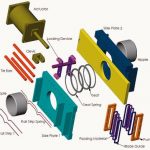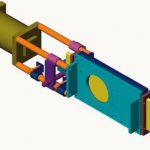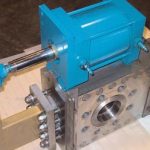When scale is formed on the moving elements of ball or gate valves, the consequence is either blocking of the valve movement or damage to the valve seats with subsequent leaking through the valves. AS-Stargate-O-Port valves have been developed to allow use in demanding applications, where scale formation and sticky substances can prevent standard valves from performing properly. These anti-scale O-port valves have been used in various industries with remarkable results.
Dirk A. Lindenbeck
There are many challenges to be met in valve applications in the process industry – corrosion, abrasion, pressure shock waves and temperature shocks to mention just a few. Less common, but often with more serious consequences, is the influence of scale formation in valves. Another problem is dealing with sticky flow media. Both these effects usually lead to problems with valve performance and frequently also have a significant impact on the safety of personnel. They are likely to cause damage to the valve seats when the valves are actuated, quickly culminating in leakage. Deviations in the process, inconsistent quality of the produced material, loss of energy and increased manufacturing costs are the result. The most critical consequence is experienced when the valves cannot be operated at the required time. Once again, this is likely to lead to inconsistent quality of the produced material, so that a considerable amount of product may be lost and – even worse – injury caused to persons if the valves have safety functions. In any case, the affected valve applications must be analysed and solutions found to minimise the effects of scaling and sticky materials.
Basic principle
Figure 1 shows the valve body, consisting of side plates 1 and 2, a blade (yellow) and various sealing elements. O-Port valves are very often confused with knife gate valves. This first impression is misleading: in fact, O-Port valves are functionally more similar to a ball valve than to a knife gate valve. O-Port valves are also referred to as through-port valves or slide gate valves. One major difference is that the blade extends through both ends of the valve body. Stuffing boxes, called packing glands, at each body end contain the blade guides. They are usually made of glass-filled Teflon. Their function is to properly position the blade inside the valve body and support it against the forces generated by the pres-sure differential between the upstream and downstream sides of the valve. The sole purpose of the packing material is thus to seal the valve from the inside to the outside and not to support the blade. This is very important for the service life of the valve. Separating guiding and sealing ensures that the packing material is not axially compressed by the pressure differential on one side, creating a leak path on the other side. The double seats seal against the flow through the valve in both directions. The valves have no preferential flow direction.
The dark brown parts are referred to as pushers or followers. These parts apply pressure against the blade guide/packing material set. This force expands the packing material and in doing so seals around the blade. A new packing material specially developed for this valve forms well around the blade and has a certain elasticity. This elasticity is important to accommodate the elastic deformation of the valve body and packing gland under pressure.
In contrast to a knife gate valve, the blade passes through both ends of the valve body and is well guided at each end in the packing glands. The blade has a hole in the middle, which is either aligned with the pipe or moved inside the valve body. The valve has spring-loaded double seats for class VI shut-off independently of the pressure differential across the valve. The sealing around the blade is as explained above (Fig.2).
Coatings
A variety of different coatings can be applied to the blade. The best coating suitable for low-temperature applications is a PTFE-based coating which creates a barrier between the blade and the flow media. This coating exhibits good adhesion to the blade but scale does not stick. The seats can therefore wipe the blade clean when the valve is actuated. A nickel-based coating is nor-mally used for high-temperature applications. The desired property is a low coefficient of friction between the coating and the flow media.
Advantages of the valves
One advantage is that no material is pushed into the bottom of the valves, preventing proper closing. A knife gate valve or a butterfly valve cannot handle solids because they get trapped between the blade or the disc and the seats. The valves have class VI shut-off, independently of the pressure differential between the upstream and downstream sides. Furthermore, O-port valves need no lubrication because there is no metal-to-metal contact between the blade and the body. The valves can be used as shut-off valves, flow control valves or line blinds. Knife gate valves or butterfly valves cannot be used as line blinds because there is always a force component opening the valves from the line pressure. In the case of ball valves, the outside indicators can show a closed position but the ball inside may be in a completely different position. The stem could be twisted or broken or there could be play between the ball and the stem.
Even in the partially open position, O-port valves have a straight flow direction, in contrast to ball valves where the flow is re-directed twice. The seats of O-port valves are not in the flow path. In the case of a ball valve in the partially open position, the flow hits the seats directly, causing premature wear. There is a short face-to-face dimension – a fraction of the space requirement of ball valves in the flow direction. On the other hand, O-port valves require more space perpendicular to the flow direction. Foreign matter does not get jammed between the gate and the body of O-port valves, because there is only a very small space between the blade and the side plate. This prevents seat damage, so that the valve always seats and seals well. Over 97 % of the body thickness is solid material, resulting in a very stiff valve body. 3 % or less is accounted for by the gaps between the blade and the side plates. O-port valves are designed for leak-free operation through the valve and from the valve body. Pressure shock waves or aggressive flow media are efficiently handled.
cpp 404
More information on the product
Achema 2006
ISA Expo 2005
Share:









